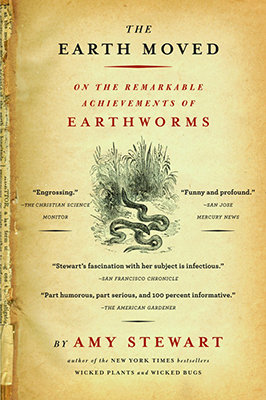9 October 2013
The Earth Moved, by Amy Stewart
Posted by Callan Bentley
 Today, I finished a book about earthworms.
Today, I finished a book about earthworms.
It wasn’t the greatest natural history book I’ve ever read, but it was the first one I’ve read specifically on the subject of worms.
I’ve gotten interested in soil ecology and chemistry. Now that I own some land, I’m curious how to manage it for maximum productivity (both natural productivity / biodiversity and also crops that can feed my family). That was also what motivated me to read Chris Bolgiano’s Living in the Appalachian Forest, about sustainable forestry. Amy Stewart, the author of today’s book, is not a forester but a gardener, and she’s interested in how earthworms’ presence can transform a garden’s productivity and the vigor of the plants that grow there.
She’s an enthusiastic narrator, and clearly very taken with the seminal work that Charles Darwin did on earthworm biology toward the end of his career. Darwin gets a chapter dedicated to his studies right off the bat, but is invoked repeatedly in subsequent chapters like a talisman of scientific authenticity. But Stewart herself isn’t a professional ecologist, and as a consequence, the scientific rigor of the book isn’t quite up to Gouldian levels. At one point, Stewart invokes theory in the (invalid) colloquial sense, a practice that makes my skin crawl. In another section (p.56), she says that some bacteria “help break down carbon, sulfur, hydrogen, and other compounds.” Which bacteria are indeed involved in breaking bonds between atoms, they sure aren’t involved in nuclear fission, which is what a strict reading of that sentence implies.
But while there’s slim rigor to her backyard experiments (they pale in comparison to those of Bernd Heinrich), she does play in her garden and records the results. This sense of the fun of fiddling with nature is infectious, and something that speaks very clearly and directly to me.
I really enjoyed the insight, revealed in one chapter wherein Steward visits Minnesota, that earthworms can be invasive pests in certain ecological circumstances. Like rabbits unleashed upon Australia, stray wrigglers tossed aside by well-meaning fishermen after a day on the lake can invade the forest humus and fundamentally alter the ecology there. Coupled with overpopulation of another species, the white-tailed deer, these stray worms gone wild have obliterated the forest understory in certain key well-studied plots.
Another chapter was dedicated to giant worms, species that in some cases can grow to two meters in length. Their biology is very poorly understood.
In a final chapter, the role of worms in transforming human waste (sewage) into nontoxic fertilizer is explored, and it looks like the town of Pacifica, California, has figured out a nice plan for making this work. Reading about her visit to the sewage treatment plant was inspirational as an exemplar of future sustainable waste management. I was impressed.
The quality of the writing is fine, but nothing to make the hair stand up on the back of one’s neck. A few typos, a few linguistic flubs, but overall clear, clean prose that’s easy to read. The Earth Moved didn’t change my life, but I’m glad I read it.


 Callan Bentley is Associate Professor of Geology at Piedmont Virginia Community College in Charlottesville, Virginia. He is a Fellow of the Geological Society of America. For his work on this blog, the National Association of Geoscience Teachers recognized him with the James Shea Award. He has also won the Outstanding Faculty Award from the State Council on Higher Education in Virginia, and the Biggs Award for Excellence in Geoscience Teaching from the Geoscience Education Division of the Geological Society of America. In previous years, Callan served as a contributing editor at EARTH magazine, President of the Geological Society of Washington and President the Geo2YC division of NAGT.
Callan Bentley is Associate Professor of Geology at Piedmont Virginia Community College in Charlottesville, Virginia. He is a Fellow of the Geological Society of America. For his work on this blog, the National Association of Geoscience Teachers recognized him with the James Shea Award. He has also won the Outstanding Faculty Award from the State Council on Higher Education in Virginia, and the Biggs Award for Excellence in Geoscience Teaching from the Geoscience Education Division of the Geological Society of America. In previous years, Callan served as a contributing editor at EARTH magazine, President of the Geological Society of Washington and President the Geo2YC division of NAGT.